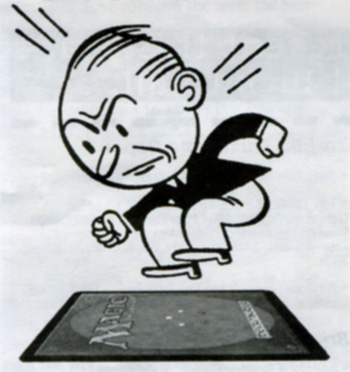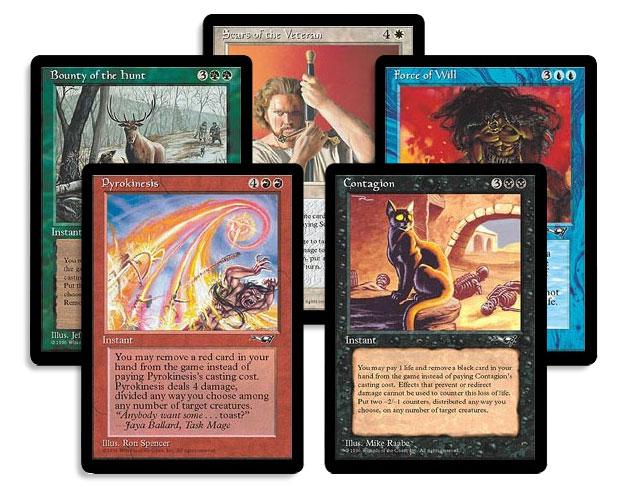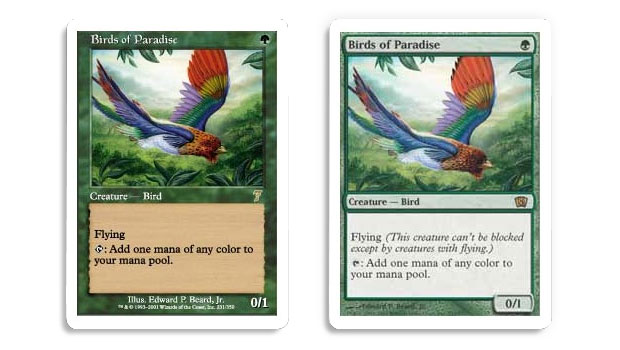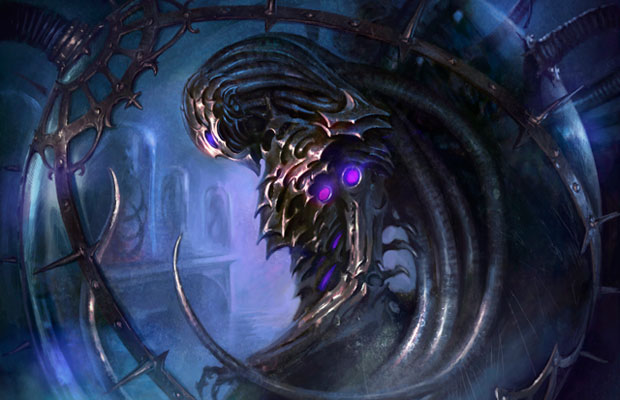Twenty Things That Were Going To Kill Magic
Welcome to 20th Anniversary Week, as we celebrate Magic's big two-oh. As one of the game's historians and the guy who most often gets the mail, I thought I'd use my column to examine some of the bigger changes Magic has gone through and how, with each change, there was always the worry that this new thing was going to be the thing that finally killed the game. My plan is to go chronologically.

- #1: The Introduction of Sixty-Card Decks and Four-Card Limits
In the beginning, deck construction rules were very simple: Pick any number of cards and put them in a deck. You must have at least forty cards total. That's it. Those were the rules.
Well, it turns out that these rules allowed complete degeneracy. In fact, Wizards once ran a tournament where players were not limited in the number of cards they played. Here's how the tournament was run: You started by showing your deck to the judges and you were stuck into one of two categories. The first category was "Able to Win on the First Turn." The second category was "Cannot Win This Tournament."
Ramp;D realized that the rules were a problem, so they introduced two changes. First, the minimum for Constructed decks was changed from forty to sixty. It remained at forty for Limited formats. Second, every card but basic lands was limited to no more than four copies. Four was chosen because it allowed some consistency for deck building but wasn't too much to ensure that the card would always be drawn every game.
The player response was loud and upset. They didn't like the idea that they couldn't play with whatever cards they wanted. The game had never had any restrictions before. Also, a sixty-card deck was a 50% increase. That was a lot more cards. What was Wizards up to?
- #2: The Creation of the Banned and Restricted List
The four-of card limits and the increase in deck size helped, but it didn't stop the degeneracy, so the next step was to further limit how many of a card players could play with. The Banned and Restricted List dealt with problem cards in two ways. Banning meant that the card was no longer allowed to be played. Restriction meant that only one copy of the card could be included in the deck.

The original list of banned cards was: Shahrazad and all the current ante cards (Bronze Tablet, Contract from Below, Darkpact, Demonic Attorney, and Jeweled Bird).
The original list of restricted cards was: Ali from Cairo, Ancestral Recall, Berserk, Black Lotus, Braingeyser, Dingus Egg, Gauntlet of Might, Icy Manipulator, Mox Emerald, Mox Jet, Mox Pearl, Mox Ruby, Mox Sapphire, Orcish Oriflamme, and Rukh Egg.
Players were again up in arms. Now there were cards they couldn't even play and most of the best cards were limited to only one. This wasn't going to stand.
- #3: The Start of Type 2 (aka Standard)
As sets kept coming out, it became clear that something else had to be done to keep the power level of the game from spiraling out of control. The solution to this was the creation of a second format. Remember, at the time, that there were no formats — just Magic. There was a single way to play. (At the time, Magic was mostly just Constructed.)
In order to create a new format, Wizards named the old one. What we now know as Vintage was called Type 1 and the new format, which only used the last few years' worth of cards, was called Type 2. The public reply to this news dwarfed any complaint that came before it. What did we mean that cards were going to rotate out of the format? Were the cards that people owned going to become obsolete?
In the history of Magic announcements, this was the one that I think had the largest outcry — which is impressive when you see some of the controversies to come. It's interesting that, so many years later, Standard has become the favorite format by such a large margin.
- #4: Nalathni Dragon
In the early days, most Magic cards were sold in expansions, but there were a few exceptions. The early Magic books each came with a coupon you could send in to get a unique card. Note that I'm not talking about an existing card with alternate art or a different layout treatment. These cards were cards that existed nowhere else but through whatever promotion they were associated with.
Then came the 1994 Dragoncon Convention. As a special promotion for attendees, Wizards created this card:
While many players were irritated by the book promos, the Nalathni Dragon made them livid. The book cards could be acquired by anyone who could get their hands on a book that was sold in many places (although mostly in North America, which created a different set of issues). To get the Nalathni Dragon, though, you had to be in Atlanta at the convention. Remember that this was before the days of eBay, so the ability to even get one, regardless of cost, especially if you lived far away from Atlanta, was near impossible.
The players made such a stink that Wizards decided to stop producing mechanically unique cards outside of booster packs. The Nalathni Dragon was also included in an early issue of The Duelist to allow players to get their hands on one.
- #5: Chronicles

The sets came fast and furious in the beginning and Wizards realized that some players had missed a lot of fun cards, so they made a set full of reprints to give those players a chance at getting some of the cards they had missed. The problem was that Wizards didn't think through the impact that reprinting old cards would have on the value of the existing cards.
You see, the early sets were printed in very small numbers, which meant that the printing of Chronicles greatly increased the supply of those cards, which impacted the value of the older versions. The newer players who got the old cards were happy, but the older players who already had them were not.
- #6: The Reserved List
As a result of the impact of Chronicles (and Fourth Edition), Wizards of the Coast tried to appease collectors by making a promise that certain cards would never get reprinted. Some players cheered the announcements but many others who were hoping the cards would be reprinted, to allow them to get some, booed.
Over the years, the Reserved List has remained a contentious issue, with players constantly calling for its abolishment but Wizards of the Coast saying it's going to honor its promise and has vowed to retain it.
- #7: Pitch Cards
Chris Page is one of the group often referred to as the East Coast Playtesters. They were a group of game players Richard met at University of Pennsylvania who playtested Magic before it was released and would go on to design a number of the early sets: Antiquities, Fallen Empires, Ice Age, and Alliances.
I first got to know Chris when he (along with Beth Moursand, one of Magic's early rules managers) became one of the proofreaders for my Magic: the Puzzling book. Chris noticed that in my puzzles, I most often tapped out the opponent to keep him/her from messing with you during the puzzle. This gave Chris an idea to make a spell that could be cast even when a player was tapped out. These cards would go on to be called the "pitch cards" and showed up in Alliances. The most famous of these cards was Force of Will.

While some players were excited by these new cards, others became freaked out. They felt that players shouldn't be able to cast spells when they are tapped out. Making cards like these was changing something about the game that shouldn't be changed. That feeling also came from within Wizards as well, as the Customer Service team wrote a letter to Peter Adkison (the then-president) urging him to stop the pitch cards from being printed.
- #8: Premium Cards
Early Magic cards existed in just one form (although there was some early experimentation with multiple pieces of artwork for common cards). That all changed with the release of Urza's Legacy. For the first time, every card existed in its normal state and in a foiled premium state. The vast majority of trading cards made use of premium versions and the Magic brand team at the time decided that Magic should as well.

Some players liked the new premium cards. They allowed players to jazz up their decks and made a greater challenge for those who loved collecting. Others, though, hated it. Magic cards were already a challenge to collect. Why make it harder? Others didn't like how the premium cards looked and felt that Magic was making a change it didn't need. The premiums went on to become rather popular, although they still have their detractors to this day.
- #9: Sixth Edition Rules
The rules of early Magic were a mess. Each ruling was made on a card-by-card basis, making a rules system that felt like it was being held together with duct tape. To solve this, Ramp;D decided to completely revamp the rules. This new rule set was introduced with the release of Sixth Edition and thus the rules change became known as the Sixth Edition rules.
The Sixth Edition rules were the largest rules change the game had ever seen. The stack was introduced, numerous rules went away, and the sequence of the turn was tightened up. It fundamentally changed the way the game was played and many of the established players didn't like it one bit. They had spent years learning the game and weren't happy to have to relearn numerous aspects. After the introduction of Standard, I believe this change created the loudest outcry from the public.
- #10: Magic Online
In the beginning, Magic was played with cards made of paper. Nine years in, there finally was a way to play Magic digitally through a computer program called, aptly enough, Magic Online. The public reacted to the news of Magic Online very skeptically. The plan to sell digital cards just like paper cards, and at the same price, seemed ludicrous. That's not how video games work.
Some argued it would never work, while others feared it would keep players from playing in stores. The Internet was full of people explaining how it could never work and how they wouldn't ever play it. Eleven years later, it's still going strong.
- #11: Eighth Edition Card Frame
One day, CAPS, the department in charge of laying out and printing the cards, explained that there were a few changes that needed to be made for printing purposes. Ramp;D saw this as a chance to fix a number of other problems with the card frames and revamp them. As this new frame first appeared in Eighth Edition, they were referred to as the Eighth Edition card frames.

This change had a huge impact on how the cards looked and many players objected to the shift. They felt the new layout had less of a fantasy feel and moved the game away from its roots. This was another very loud outcry with many words written both in articles and on message boards.
- #12: Evergreen Keyword Reminder Text
Eighth Edition brought not one, but two controversies. While everyone at Wizards of the Coast saw the anger over the card frame change coming, this next one was a little more of a shock. As the core set has always been the place for new players to start, Ramp;D decided to begin including reminder text with the evergreen creature keywords (flying, first strike, etc.).
Numerous players found the reminder text offensive, as they saw it as yet another example of Ramp;D catering to new players. The reminder text, they felt, was unnecessary and just added extra words to clunk up the card. Evergreen reminder text would later find its way to lower rarity cards in expansions.
- #13: Planeswalkers
For fourteen years, Magic had had the same card types that it had begun with. Sure, interrupts had been folded into instants and there had been some experimentations with "mana sources," but overall, card types were as they were in Alpha. Then came Lorwyn and something new was added to the mix, a brand-new card type called Planeswalkers.
Planeswalkers were very different. For starters, they only existed at rare. They were complex enough that the cards themselves didn't even explain to you how they worked. And they looked unlike anything Magic had done before. Some players were excited by this new addition but other players were unhappy. They disliked that the new cards would be harder to get than other card types that each had cards in all — at the time — three rarities. They disliked that they required you playing creatures. They disliked that they were not that easy to understand.

It would have been hard to predict from the original reaction that Planeswalkers would go on to be wildly popular, so much so that Ramp;D started making sure to put at least one into every expansion.
- #14: Mythic Rares
Magic was the first trading card game, but many others followed in its path. One of the changes most trading card games made was that they had more than three rarities. Realizing that the extra rarity, something rarer than one in every pack, could add some extra excitement and reinvigorate the collecting aspect of the game, Wizards opted to add the fourth rarity, starting with Shards of Alara.
The addition of mythic rares was introduced in an article I wrote (called "The Year of Living Changerously") and I don't think I've ever written a column that has generated a louder response. Many players hated the idea of a new harder-to-collect rarity, even if it made other rarities easier to collect. The debate has shifted over the years from "should there be mythic rares?" to "which cards should be mythic rares?" but it is still a hot-button topic.
- #15: Lands in Boosters
When Magic began, sets were sold in both starters and boosters. Starters were boxes that held seventy-five (originally sixty) cards, including thirty land. When the starters (later called tournament decks) were phased out, it was unclear how exactly new players would be able to get basic lands. Intro Packs and Fat Packs would have land, but what about a player who just bought boosters? The solution to the problem was to replace one of the common cards with a basic land.

Forest | Art by Eytan Zana
While this was a good thing for newer players, some of the established players weren't so happy with the change. They felt that they were getting one less card, which would impact both their collection and limited play.
- #16: Magic 2010 Rules Change
Magic had core sets since the beginning, but Aaron Forsythe decided that they needed a shake-up. For the first time, the core set included new cards, and it embraced a dedication to resonance that hadn't been seen since the early days of the game. None of that, though, was the controversial part. The thing that caused the outcry was a series of rules changes known as the Magic 2010 rules change.
For starters, "damage on the stack" was removed. Ramp;D felt that it created situations that didn't feel natural and that removing it would lead to more dynamic play. Mana burn was removed as part of a move to lessen things that players needed to track but happened infrequently. New terminology like "the battlefield" and "exiled" were added to help add flavor and simplify verbiage. The article that explained these changes is, to date, the most-read article on DailyMTG.com.
The reaction wasn't quite as strong as the last big rules change with Six Edition but it was vocal, nonetheless. Many players felt the changes weren't needed and lessened the quality of the game. With time, as with the Sixth Edition rules, the players have come to embrace them.
- #17: New World Order
One of the biggest barriers to Magic has always been the steep learning curve. Ramp;D set out to address this problem by rethinking how much complexity was put onto common cards. This revamping of how common cards were made was referred to in Ramp;D as New World Order.
New World Order led to an outcry from some players who felt Ramp;D was "dumbing down the game" and that issue still pops up from time to time, even to this day. The data, including sales, have shown that Ramp;D's approach with New World Order seems to be working well.
- #18: Double-Faced Cards
Innistrad wanted to find a way to show transformation to make werewolves and other horror tropes. They borrowed an idea from another game Wizards makes called Duel Masters (and, more recently, Kaijudo) — cards with faces on both sides. Some players felt the Magic back was a hard-and-fast rule that could never be broken, so the idea of cards without one upset them greatly.
They required sleeves or a checklist card. They messed up Draft. They made players have to de-sleeve and flip them over. Every flaw was pointed out time and time again. Despite that, though, they went on to be the highest-ranked mechanical component in Innistrad and Dark Ascension. There was even a large outcry when the last set in the block, Avacyn Restored, didn't have any.
- #19: Organized Play Changes
This change was a number of things, from the replacement of the ELO rating system to Planeswalker Points to the elimination of the Magic World Championships to abolishment of pro points. The outcry was fast and loud, coming from many of the top names of the Pro Tour, who claimed the changes were detrimental to the entire organized play system.
Wizards of the Coast listened and made numerous changes a few months later, reinstating pro points and creating a new system to fill the role of the World Championships.
- #20: New Slivers in Magic 2014
The latest controversy happened just earlier this year, when the contents of Magic 2014 were announced. Slivers, a fan favorite, were coming back, but they were returning with two changes — one mechanical and one cosmetic. For the former, Slivers now only affected Slivers controlled by the same player. For the latter, the Slivers gave up their iconic talon-shaped look for something more humanoid shaped.

Sliver Construct | Art by Mathias Kollros
The mechanical change was disliked, as many felt it contradicted the hive-mind feel of the Slivers. The new look was disliked because it was felt to be too much of a departure from what some believed was one of the most unique and iconic creatures in Magic.
- Twenty Answers
And that's twenty. As you can see, Magic's been through a lot in its twenty-year history. Hopefully, today's article allowed you a little glimpse through that history, either to learn some things you didn't know about or let you reminisce if you did.
So how was my list? Did I fail to include something you would have? Which of my list was dead on? I'd love to hear your reaction in my email, in the thread to this column or on my social media (Twitter, Tumblr, and Google+). Also, if you'd like to share any of your stories from the last twenty years, I'd love to hear them.
That's all I got for today. Join me next week when I explore something from Magic's past that you've never seen.
Until then, may Magic continue to be hard to kill.
Working for Magic Ramp;D since October, 1995, Mark Rosewater is currently the head designer. His hobbies include spending time with his family, talking about Magic on every known medium (including a daily blog and a weekly podcast), and writing about himself in the third person.

